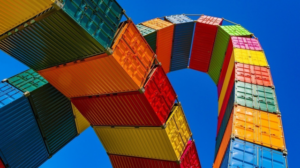In 1992, an unusual event sparked global interest: a shipping container accidentally fell into the ocean, releasing 28,000 rubber duckies and other children’s bath toys. These small, yellow ducklings embarked on a journey across the world’s oceans, with some washing up on shores as far away as Alaska and Maine. This odd occurrence brought attention to a larger, growing problem in the shipping industry: the loss of containers at sea.
Six years later, the APL China ship, en route from Taiwan to Seattle, lost 406 containers overboard after being hit by Hurricane Babs, while another 1,000 were damaged. Such incidents are not isolated. According to a report by the World Shipping Council (WSC), up to 1,382 containers are lost annually. Meanwhile, the Associated Press estimates that over the past 15 years, more than 20,000 containers have sunk into the oceans, though some experts believe the number could be even higher.
The Environmental Impact of Lost Containers
While the image of floating rubber duckies may seem innocent or amusing, the environmental impact of these lost containers is anything but. Containers that sink or break open can spill their contents, which range from electronics and plastics to hazardous materials, causing significant damage to marine ecosystems. Plastics, in particular, pose a huge threat. When released into the ocean, they break down into microplastics, which marine life ingest, leading to contamination of the food chain and harming marine biodiversity.
Additionally, some containers carry toxic or chemical substances. When these substances are released, they can disrupt delicate marine environments, poisoning aquatic life and polluting water sources. The materials from the containers can settle on the ocean floor, smothering coral reefs and damaging habitats for a wide range of species.
Navigation and Marine Life Hazards
Containers that remain floating near the ocean surface create serious hazards for ships and marine life. Unseen below the waterline, these “ghost containers” can cause accidents, damage ships or even lead to collisions. For marine animals, especially large species like whales, these containers pose a physical threat. Whales and other sea creatures may collide with containers or become entangled in debris, leading to injury or death.
The Global Response and Solutions
In response to these growing environmental concerns, shipping companies and regulators are working to improve container tracking and recovery efforts. Stricter regulations on how containers are packed and secured, as well as advancements in satellite tracking, have been introduced to prevent further losses. However, retrieving lost containers remains a significant challenge, especially those that sink deep into the ocean.
In addition to preventing losses, efforts to clean up the ocean are being ramped up. Ocean cleanup initiatives are now focusing on reducing the amount of plastic and debris entering marine ecosystems, as well as raising awareness about the environmental consequences of container spills.
A Call for Action
The story of the rubber duckies highlights the unpredictability of container spills but also serves as a reminder of the far-reaching consequences these incidents have on the environment. With thousands of containers lost at sea every year, the need for stronger prevention measures, better tracking technology, and ongoing cleanup efforts is critical to safeguarding our oceans. Ultimately, protecting marine ecosystems from the harmful effects of lost containers is not just about environmental preservation but about ensuring a sustainable future for life both in and out of the water.
Ask me anything
Explore related questions





